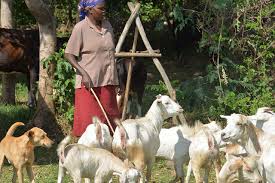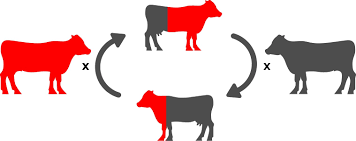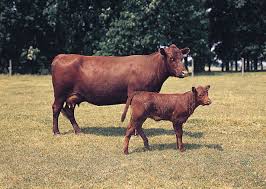Breeding methods, also known as mating systems, refer to the various schemes designed to bring selected male and female animals together as parents for future generations.
This step follows the selection of breeding stock and is essential for achieving specific breeding objectives. Understanding and applying the appropriate breeding system is critical to maximizing livestock productivity and genetic improvement.
Read Also: 19 Medicinal Health Benefits Of Cleavers (Galium aparine)
Breeding Decisions After Selection

Once the breeding animals have been selected, the next step is determining how these individuals will be mated. This process is what defines the breeding method or mating system.
While there are many possible strategies, most fall into two broad categories: those based on animal performance or expectations (e.g., random mating) and those based on pedigree relationships (e.g., inbreeding and outbreeding).
Random Mating
Random mating is the simplest breeding method. All males have an equal opportunity to mate with any female within the population. This system requires no records of performance or genetic predictions, making it ideal when time and data are limited.
Random mating is commonly used to establish control populations in research and commercial breeding programs with large animal numbers or limited performance data. It also helps estimate genetic parameters like heritability and genetic correlation.
Inbreeding
Inbreeding involves mating individuals that are more closely related than the average of the population, sharing genes due to common ancestors. This method increases homozygosity, which may fix desirable traits but can also result in negative outcomes known as inbreeding depression.
A. Traits Affected by Inbreeding Depression
i. Dairy cattle: Reduced milk and butterfat yield, growth rate, calf viability
ii. Beef cattle: Reduced weaning weight
iii. Swine: Lower body weight, smaller litter size, reduced piglet viability
iv. Sheep: Lower weaning weight, yearling weight, and wool traits (clean wool, staple length)
v. Poultry: Reduced body weight, egg number and weight, hatchability, delayed sexual maturity, and lower viability
B. Disadvantages of Inbreeding
- Increased risk of harmful genes combining and producing abnormal offspring
- Loss of vigour and performance
- Inbreeding depression, which leads to decreased fertility, higher embryonic mortality, lower survival and growth rates, and reduced milk yield. Fitness traits are most affected, while carcass traits remain relatively stable.
Outbreeding
Outbreeding is the opposite of inbreeding and involves mating animals of the same breed with minimal genetic relationship. This method introduces new genes, enhances variability, and increases heterozygosity, which can be beneficial for population performance.
Read Also: 19 The Medicinal Health Benefits of Reishi Mushroom (Ganoderma lucidum)
Crossbreeding Systems

Crossbreeding refers to the mating of two genetically unrelated populations or breeds to combine their traits in the offspring. If the offspring outperform the average of the parent breeds, this indicates heterosis (hybrid vigour). Traits that are non-additive in nature benefit the most from heterosis.
A. Example of Crossbreeding
The broiler industry is based on crossbreeding:
i. Sire line (White Cornish): Selected for growth and conformation
ii. Dam line (White Rock): Selected for egg size and production, sometimes with dwarf genes for improved hatchability and feed efficiency
This combination leads to superior progeny performance through hybrid vigour.
B. Crossbreeding Schemes
1. Backcrossing: The first-generation cross is mated back to one of the parent breeds, resulting in 75% genetic material from one breed and 25% from the other.
2. Crisscrossing: Begins with two breeds (A and B). A × B cross is mated back to A (75% A, 25% B), then back to B (62.5% B, 37.5% A), continuing alternately.
3. Top crossing: Involves reintroducing genetics from the original breed population to refresh and improve the existing gene pool. For example, British Friesian breeders sourcing bulls from Holland.
4. Grading-up: Involves repeated mating of native females with sires from an improved breed to increase the frequency of desirable traits. Common in developing countries. Example: Friesian sire crossed with Bunaji dams.
5. Rotational crossing: A multi-breed system (three or more) where breeds are used in succession. For instance:
MaleFemaleLimousin (L)Hereford (H)Simmental (S)(LH) Charolais (C)Brown Swiss (B)(LHSC) Hereford (H)
This method expands genetic diversity and combines strengths from multiple breeds.
Each breeding method has a specific role in livestock improvement. Inbreeding should be used cautiously and only for a few generations to avoid depression effects.
Crossbreeding remains the most effective strategy when different breeds are available, as it enhances performance through hybrid vigour. A breeder’s choice of method should align with the production goals and available resources to ensure sustained genetic progress and productivity.
Do you have any questions, suggestions, or contributions? If so, please feel free to use the comment box below to share your thoughts. We also encourage you to kindly share this information with others who might benefit from it. Since we can’t reach everyone at once, we truly appreciate your help in spreading the word. Thank you so much for your support and for sharing!
Frequently Asked Questions
We will update this section soon.

